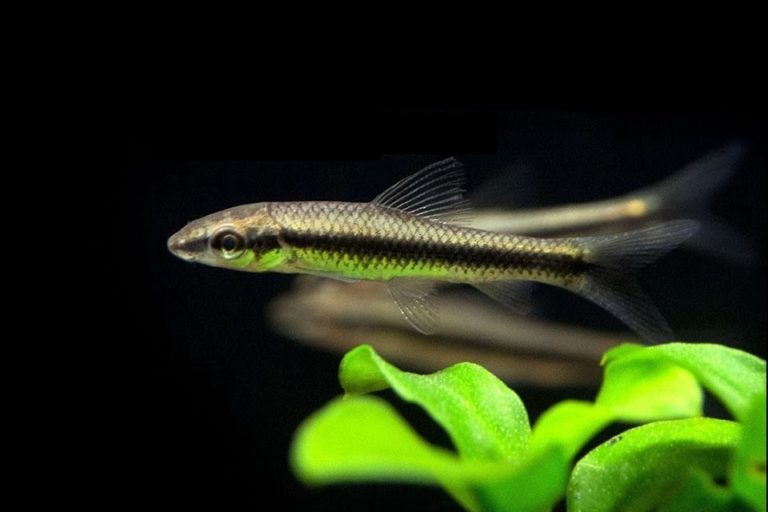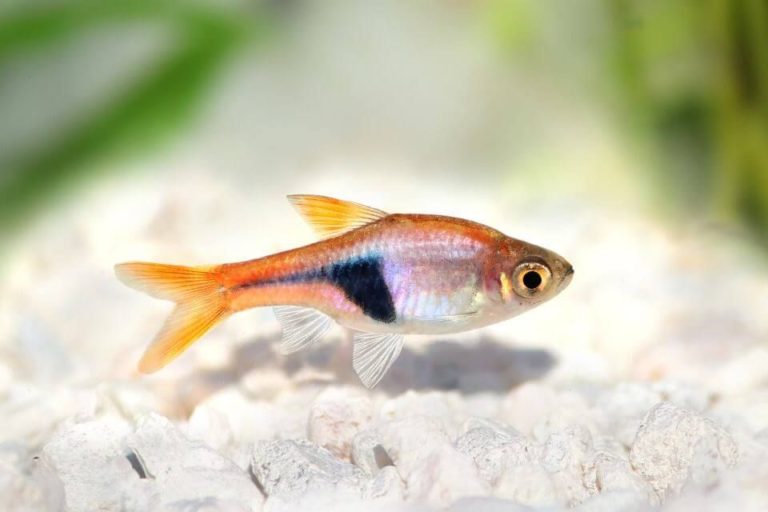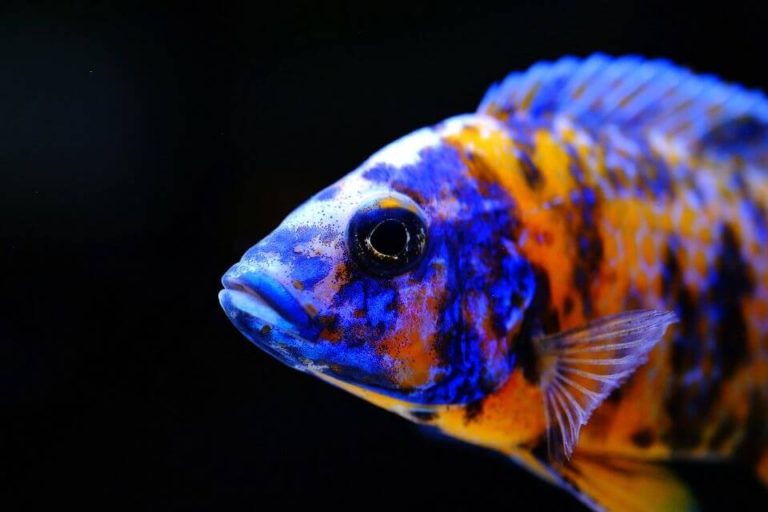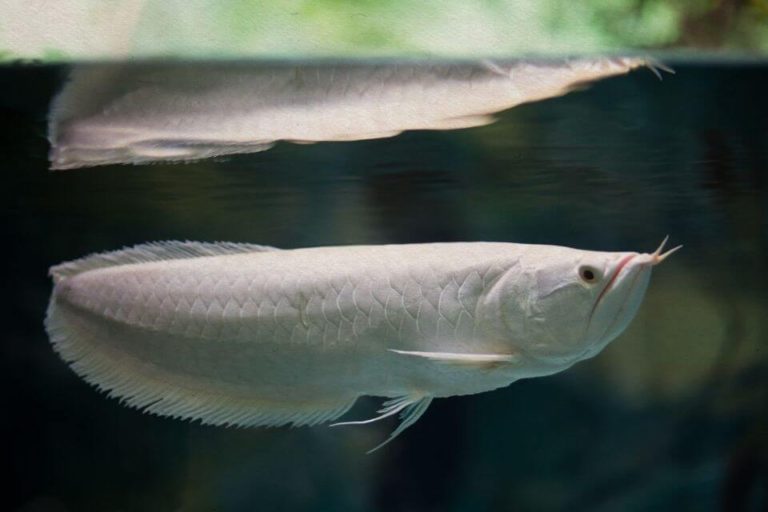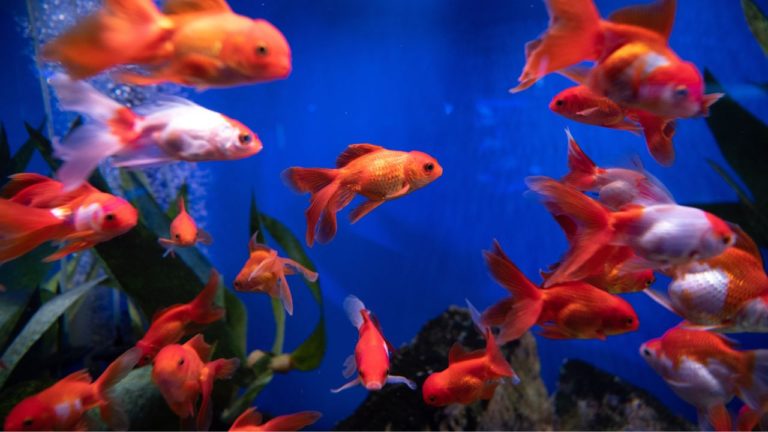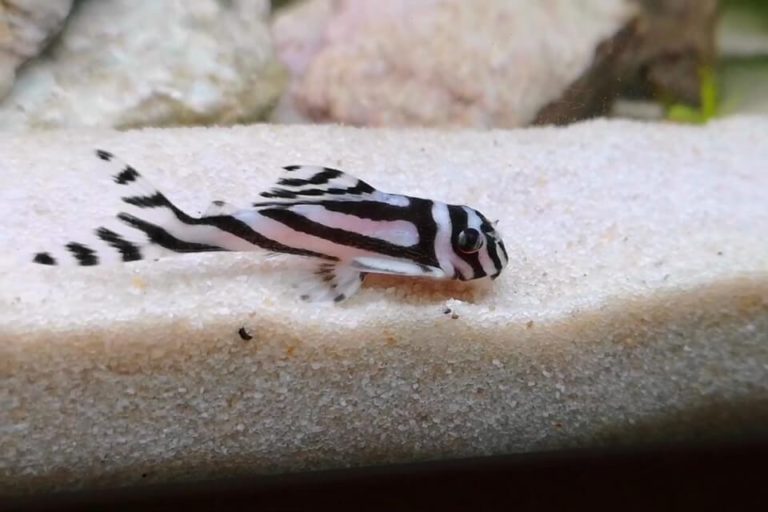29 Best Freshwater Aquarium Fish Species for Beginners (with Pictures)
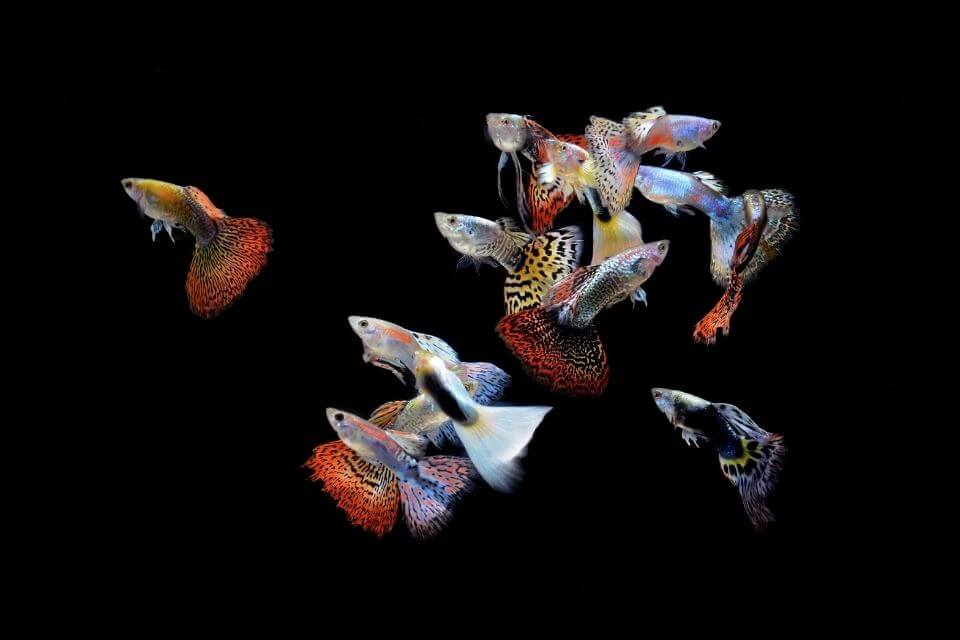
Nothing beats the excitement of adding a new Freshwater Aquarium Fish to your newly set up aquarium. However, the fish species you choose will determine or rather have a great impact on your aquarium’s success or failure.
Unfortunately, beginners make the wrong choices and end up losing their fish and end up giving up on fish keeping hobby.
As a beginner, you do not know how to fix fishkeeping problems quickly and, therefore, you need hardy fish that can withstand poor water and tank conditions for some time and survive.
Although poor water conditions are not an option, as a beginner you will make such mistakes. Below are the 30 Best Freshwater Aquarium Fish species for beginners that are very easy to care for.
1. Guppy Fish
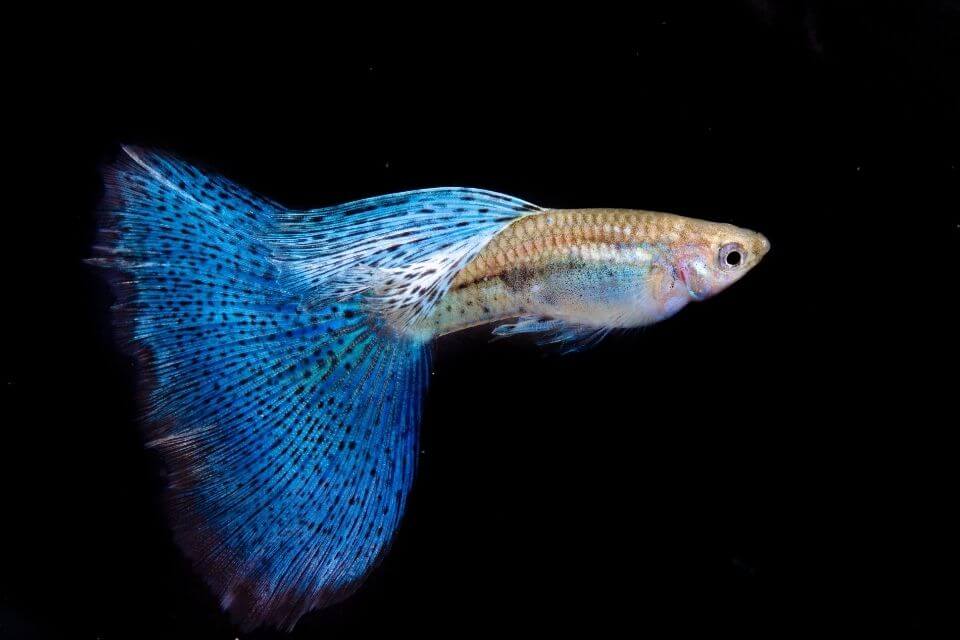
Guppy fish species, sometimes called Rainbow Fish or Millionfish originate from South and Northeast America, but lately, it is bred in captivity.
They are one of the best choices of Freshwater Aquarium Fish if you are a beginner fishkeeper and are very easy to care for.
They are scientifically known as “Poecilia reticulata” and belong to the “Poeciliidae” fish family.
In the wild, guppy fish live in large numbers to protect themselves from predators like birds and large fish. Although this species prefers freshwater environments, they can still survive in brackish habitats too.
Guppies are mostly peaceful, calm, and laid-back fish that do not show any aggressive or territorial tendencies. However, male guppies can be aggressive with other male guppies.
It is necessary to keep them in a tank with a hood since some fish keepers have reported that this species can jump out of the tank.
Guppies come in different colors and patterns with different tail styles and lengths. They are categorized according to their tail type, color, and their eye color.
Most guppies are either two-toned or three-toned and their colors include black, orange, purple, silver, green, pink, red, and blue. Some common types of guppy tails are flag tails, fantails, spire tails, round tails, and vein tails.
The biggest difference between the female and male guppies is their size. The female guppies are bigger than males when fully grown and male Guppies are more slender than females.
The male guppies reach an average size of about 2 inches while the females can be 2.5 to 3 inches. Guppy Fish’s lifespan is about 2 to 3 years. A Group of 5 to 6 Guppy Fish can easily fit in a 10 gallons fish tank.
Guppies are easy to care for and are great for beginners since they can adapt to varying water conditions. These omnivores are not peaky eaters and can consume most foods without deterring their health.
In the wild, guppies feed on a varied diet including insects, algae, invertebrates, and mineral particles depending on availability.
In the aquarium, the diet is the same including a combination of high-quality fish flakes, algae wafers, and frozen foods like bloodworms to ensure sufficient nutrients and low risks of deficiencies.
2. Platy Fish

The Platy Fish has two different varieties the Southern Platy Fish (Xiphophorus maculatus) and Variable Platyfish (Xiphophorus variatus) both fall under the Poeciliidae fish family.
The Platy Fish is one of the best options for freshwater aquarium fish if you are new to the fishkeeping hobby.
It originates from Central and Southern America, mostly in the region of Vera Cruz, Mexico, to be precise. They prefer warm water bodies with silty bottoms or vegetation including marshes canals and springs.
Platy Fish are very peaceful fish species. The males might pester females and thus a great idea if you have two females for every male to prevent the males from harassing one female.
The Platies have about 170 species of varied colorful species. They seemingly have a variety of patterned and solid colors as breeders continue to come up with new species variations every year.
They are easy to care for being able to withstand different water conditions. They do well in a community tank meaning they can co-exist with other non-aggressive fish in the tank.
The size of these Platy Fish is about 2.5 inches and the females are normally a bit larger than the males. The lifespan of Platyfish is about 3 to 4 years.
A group of 5 to 6 fish can be kept in a 10 gallons fish tank with a well-planted aquarium environment.
They are omnivores but need much more herbivore foods preferably a blend of plant-based diet and proteins including meats. Some of the vegetables they feed on include squash, cucumbers, and spinach.
If they do not eat their food within minutes, you are overfeeding them.
3. Molly Fish
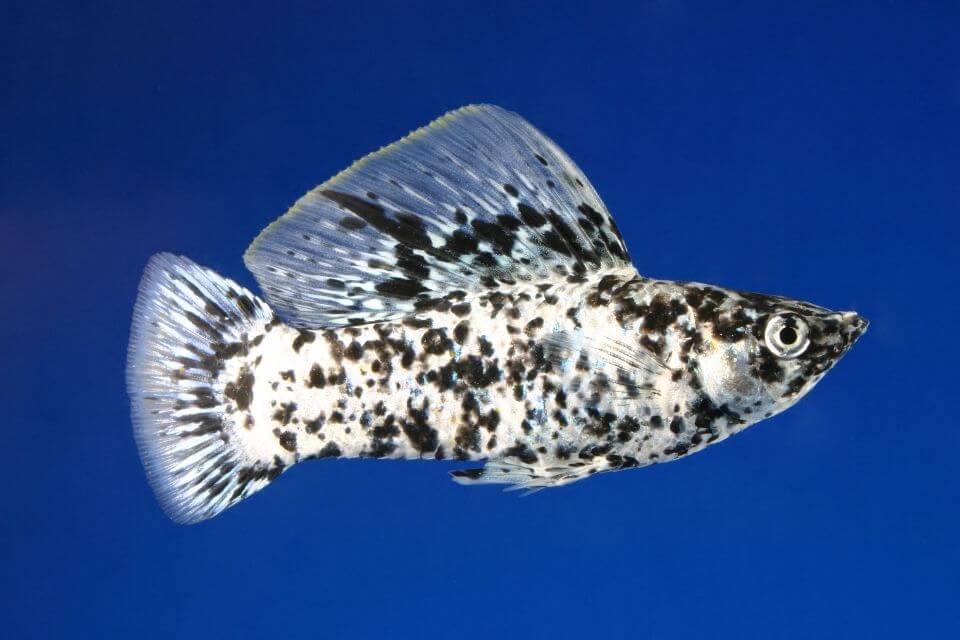
Mollies originate from Southern U.S.A down into Central America but their native habitats extend to the Yucatan Peninsula in Mexico. They are one of the most popular freshwater fish kept by hobbyists worldwide.
Mollies are moderately peaceful and enjoy schooling together. However, they can show signs of aggression if the aquarium is overcrowded. Ideally, the tank should have more females than males with a ratio of 3:1. This will prevent the males from harassing the females allowing the tension to be spread equally.
There are numerous molly varieties with the main differences being their colors and patterns, but their shape and sizes can differ too. The common molly fish has a flattened. They are wide in the middle but narrow towards a point at their mouth.
Mollies in captivity have been interbred resulting in many different colors. The most common varieties are the solid black mollies with sailfin types and orange-bordered dorsal fins.
Their sizes are 2 to 4 inches depending on the species and have a lifespan of 3 to 5 years depending on your tank setting. Mollies are easy to care for, but keeping both sexes can be a problem for beginners because they are prolific breeders.
Mollies are omnivores making them easy to provide for. They eat all kinds of food, but their preferred diet is plants and algae. Small pieces of vegetables including zucchini, spinach, and lettuce are important as well.
4. Dwarf Gourami
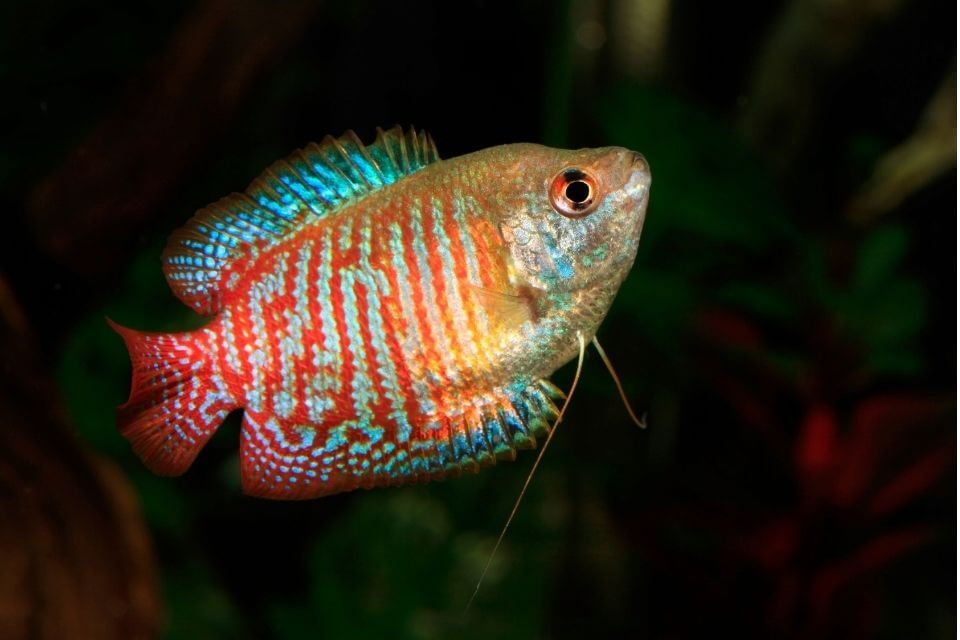
The Dwarf Gourami is ranked among the most beautiful aquarium fish and precisely the most beautiful Gourami. Sometimes they are called Sunset Gourami, Flame Gourami, and Red Gourami.
This species originates from India, Assam, West Bengal, and Bangladesh. Most hobbyists describe these fish as peaceful, shy, and electrifying when describing their experiences. If you have a pair of gouramis, they will swim together.
These striking small fish come in numerous colors, but the most popular color is flame. Their bodies are narrow and compressed on the sides while their fins are large and slightly round. Their dorsal and anal fins are merged.
Dwarf gouramis when fully grown can reach up to 3.5 inches in size, but their average size is about 3 inches. They live for four to six (6) years, but these can extend up to eight years with a nutritious diet and optimum water conditions.
Dwarf Gourami care is moderate since this species is hardy and adapts quickly to various water parameters. They are easily frightened thus the tank should be in a quiet place.
Their diet is varied since they are omnivores. They eat algae and small insects in the wild and to mimic this, you can feed them will algae-based flake food, tubifex, freeze-dried bloodworms, and brine shrimp.
5. Neon Tetra
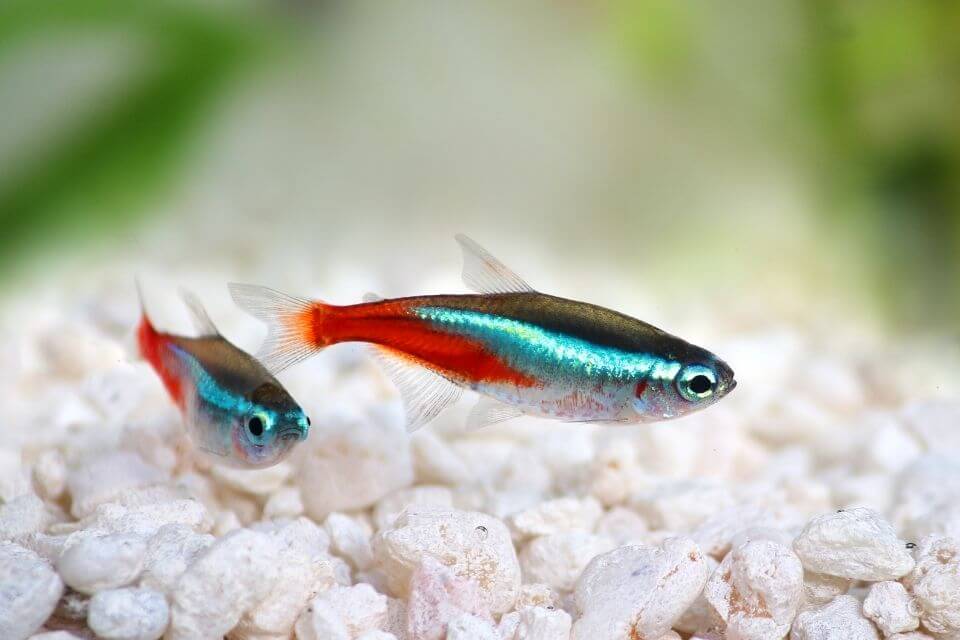
Neon tetras originate from the steams and tributaries in the Amazon River basins in Columbia, Brazil, and Peru. The are of the blackwaters beneath the thick forest canopies that allow minimal light to get through.
Caring for Neon Tetras is pretty easy because they are non-aggressive, peaceful fish that makes a great addition to a community tank. These fish spend time in a school while swimming in the middle of the water column.
In appearance, neon tetras are light gray to beige on the back. They have a nose spot of striking red. Their body shape is just like that of other fish but with distinct dividing lines at or near the tail.
The fish have silver scales around their dorsal fins, eyes, and tails. Neon tetras vary in color but they are typically orange, green, blue, pink, yellow, red, silver, or gold.
They grow up to 2.5 inches in captivity and achieve a length of 1.5 inches after 12 months. Neon tetra can live 5 to 8 years in captivity, but their lifespan can be extended if maintained properly.
These species love to eat. They are easy to feed taking most pellets and flake foods. They can be fed with live foods including bloodworms, or daphnia. Frozen foods are acceptable.
They should finish their food within 2 minutes to avoid contaminating the water.
6. Paradise Fish (Paradise Gourami)
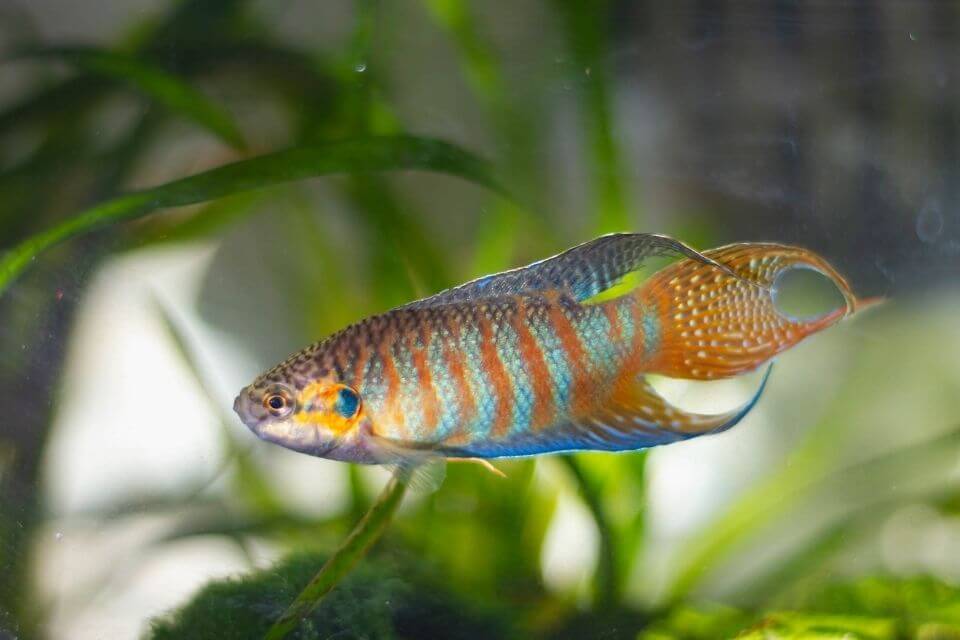
The Paradise Gourami (aka Paradise Fish) is found across a wide range of southeast Asia. In China, this species is found from the east of the Yangtze River basin stretching to the pearl river basin on Hainan Island and in Hong Kong.
The Paradise Fish is an aggressive species which makes it a poor choice for a community tank mostly the more timid fish or smaller species because they could be eaten.
The paradise fish is just amazing. When you see it swimming around, it is really captivating. Their bodies have long fins with colorful patterns which makes their motion seen elegantly.
Their anal and dorsal fins mimic each other and angle backward past their caudal peduncle. The most common color variant is blue and reddish-orange which fades approaching the top of their head.
The average size of a paradise fish is about 3 inches with a lifespan of between 7 to 9 years. The fish are very tolerant to a wide range of tank conditions including a wide range of water temperatures making them easy to take care of.
These fish are omnivores and will consume different types of foods. They eat both animal and plant matter. Their diet should be rich in proteins. If you feed them with vegetables, just ensure it is a supplement to meats.
Live and frozen foods are a perfect way to introduce proteins into their diets.
7. Sparkling Gourami
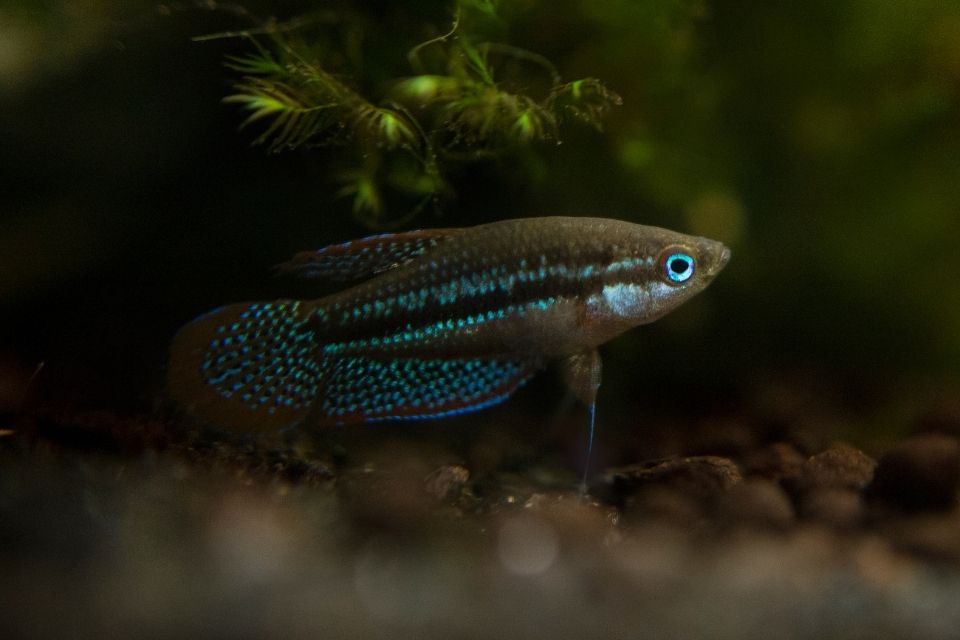
The Sparkling Gourami is also known as Pygmy Gourami. It is a small freshwater fish that is native to slow rivers, ponds, and rice fields of Southeast Asia. They are best known for their speaking ability and dazzling appearance.
The Sparkling gourami is a gentle and peaceful fish. This species does want to cause trouble and will always try to avoid conflict whenever necessary. Shoaling makes gouramis more comfortable in the aquarium.
Keeping them together gives them a sense of social enrichment and a sense of safety thus improving their quality of life. The Sparkling gourami is undoubtedly a beautiful fish. It has so many vibrant colors and stylish patterns packed into its small body.
True to their name, the fish are a little like sparkling bullets when they are swimming around the tank. They have a thin long and streamlined body.
The average size of sparkling gourami is around 1.5 inches when fully grown. They are quite small and thus do not need a large aquarium to thrive. They have a lifespan of 4 to 5 years.
Sparkling gouramis are easy to take care of no matter the level of your experience. They are hardy and can thrive in a wide range of environmental conditions.
Sparkling gouramis are omnivores, but in their natural habitats, they mostly feed on zooplankton and insects Ensure you feed them with enough protein in their diet and a consistent amount of daphnia, bloodworms, and artemia.
8. Tiger Barb
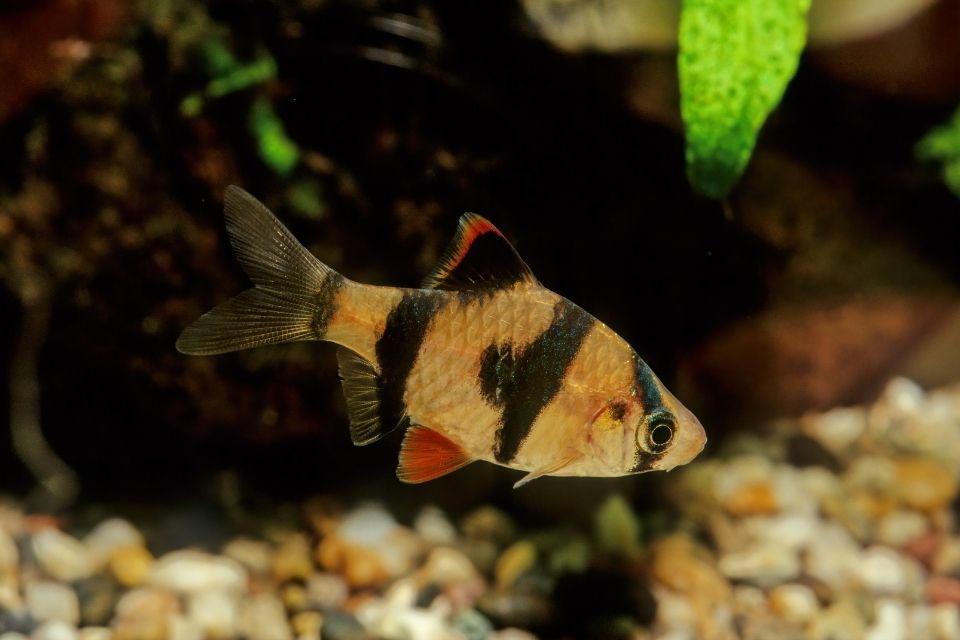
The Tiger Barb is native to Malaysia and Borneo including Kalimantan and Sarawak. Tiger Barb can also be found in Cambodia, Thailand, and the island of Sumatra.
These fish inhabit tributaries lined with sand, quiet-tree-lined rivers, and thick vegetables where they can feed on invertebrates, algae insects, and detritus.
Tiger Barbs are semi-aggressive with the tendency of bullying other smaller vulnerable fish species if put in the same tank. Besides, they are very active and are commonly known for being playful.
Tiger Barbs are shaped like spear points or barbs with wide flared bodies and triangular snouts. Their colors resemble the animal they are named after with 4 large black bands, golden yellow, and bright orange markings on the fins and snouts.
Their scales can be pale silver gold red or green. They have an average size of 2 to 3 inches with a lifespan of 5 to 7 years.
Tiger Barbs can tolerate a wide range of temperatures and water conditions but they thrive best in soft and slightly acidic water. They can be kept even in an unheated tank making it easy for beginners.
Tiger Barbs are omnivores accepting virtually any food. To maintain a healthy immune system, they should be fed on frozen foods such as bloodworms, shrimp beef heart, and quality flake food.
Tager Barb care is not that hard even for a novice fishkeeper because these fish species are not demanding fish.
9. Cherry Barb

Cherry Barb is native to Sri Lanka. They are found in the Nilwala River to Kelani River basins. These fish species are highly overfished and are at risk while in the wild.
The loss of their natural habitats and poaching have caused their numbers to decline. Cherry Barbs are peaceful are feel safe when kept in a school of about six or more.
These fish can be shy and keeping them in a school is important to make them feel comfortable. They are ranked among the most common freshwater fish species for hobbyists. Cherry Barbs have a lateral stripe that extends from head to tail.
They also have elongated bodies Females tend to have a rounder stomachs while males are slimmer and brightly colored. Most Cherry Barbs are primarily tan or dark brown with highlights of orange or red.
They have an average size of 1 to 2 inches with a lifespan of 5 to 7 years. The fish are extremely hardy and easy to take care of. This makes them beginner-friendly. They rarely pick up diseases if kept in optimal water conditions.
Cherry Barbs are omnivores and will eat anything that gets into their mouth. Caring for Cherry Barb is very easy which makes it beginner-friendly fish species. Diatoms, plant matter, algae, crustaceans, and zooplankton.
In captivity, they can be fed with live and frozen foods such as daphnia, shrimp, or bloodworms to keep them happy.
10. Common Goldfish
The common Goldfish name originates from a color mutation that happened when the Chinese started domesticating carp for food. The goldfish are found in shallow and calm waters such as streams rivers, reservoirs, and lakes.
Through mutations, fish that are gold, red, or yellow emerge hence the name goldfish. These fish are very peaceful and are common at striking and display red, black, orange, yellow, and grey formations.
Aggressive tankmates, small tank sizes, and poor water quality contribute to their stress. They are rarely aggressive but can fight for food if they are underfed.
The difference between the males and the females is subtle. The male fish display spots on their fins and gills during mating thus helping them to have sex with the species. Their colors and patterns vary due to their numerous mutations.
The common goldfish can reach the size of about 12 to 14 inches and have a lifespan of about 10 to 15 years. The fish are easy to care for since they are hardy and can live in a variety of tanks making them suitable for beginners.
The common goldfish are omnivores thus their diet consists of both animals and plants. They can scavenge on the bottom of the water feeding on plant materials, crustaceans, and small insects in the wild.
In captivity, they can feed on pellet foods, flakes feeder shrimp, and bloodworms.
11. Golden Wonder Killifish
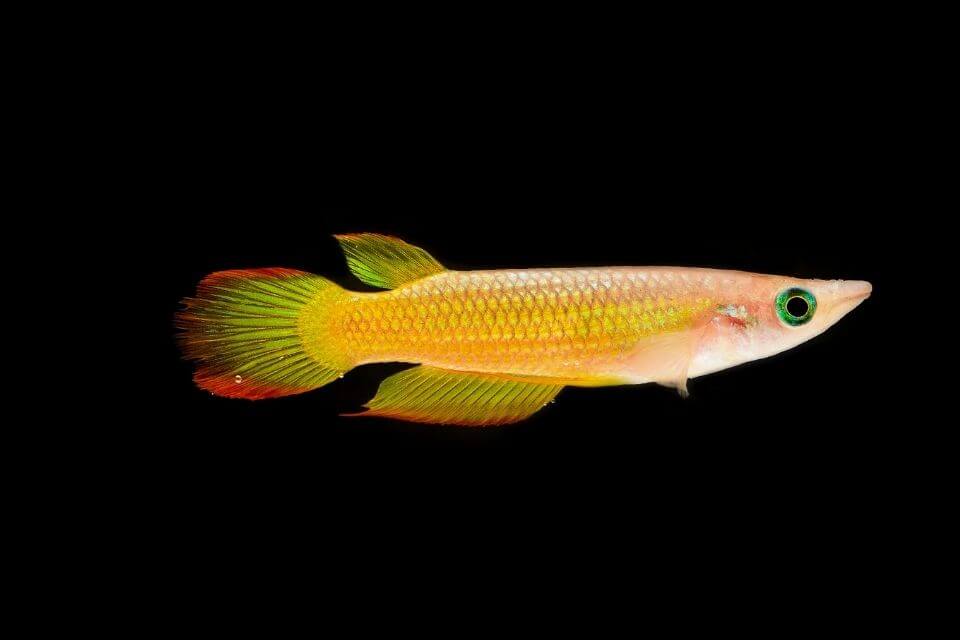
The Golden Wonder Killifish is a very colorful and undemanding fish that is incredibly popular among hobbyists over the years. The fish is commonly known as Malabar Killifish or Striped Panchax.
In most cases, its social behavior is peaceful loosely shoaling in small groups. Unless this species feels threatened, it rarely portrays aggressive behavior.
The colors of the Killifish are greenish flanks, bronze back, and metallic gold appearance scales. The males have blue to yellow bodies that are brightly colored portraying orange stripes and spots.
The males are brighter than the females with flat heads at the top. Interestingly, their mouths are near or rather at the tip of their face or even underneath with long pointed, and curved teeth.
In their natural habitats, the Golden Wonder Killifish can reach a maximum size of 4 inches while in captivity they grow up to 3 inches in length. These species can live up to 4 years.
They adapt quickly to varying tank conditions with a water PH of about 6 to 7. The Golden Wonder Killifish are carnivores meaning they feed entirely on meaty items such as insects, worms, and crustaceans. You can also feed them with flakes and pellets.
12. German Blue Ram
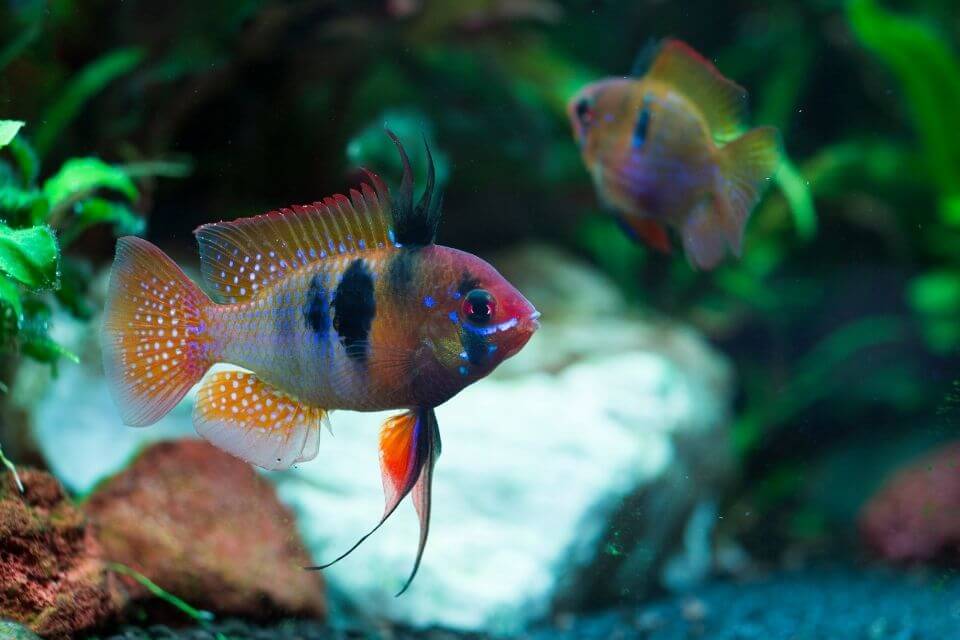
The German Blue Ram, also known as the Ram Cichlid originates from South America. The species’ natural habitat is the Orinoco River basin in Columbia and Venezuela.
The fish is quite peaceful, unlike the rest of the Cichlids. These species do not have a preferred tank position and spend their entire time swimming around the aquarium.
The German Blue Ram is very colorful with a bright yellowish and an almost green body with their head being blue/white. Their eyes are red while their fins are red or yellow with blue lines that are almost transparent.
They have spiny rays in their fins which prevent them from being attacked or eaten by larger fish. These species can reach a length of about 2 to 3 inches when fully grown with a life expectancy of about 3 to 4 years.
They are moderate to care for since they are quite sensitive to the water parameters mostly the nitrate levels. Placing them in a new aquarium can be difficult.
The German blue rams are omnivores meaning they consume a varied diet of both plants and meat. In the wild, they feed on invertebrates or insects and plant materials floating on water.
In captivity, you can feed them plants and vegetables to maintain a balanced diet. You can also add flakes and pellets but they should not be the basis of their diet.
13. Clown Loach
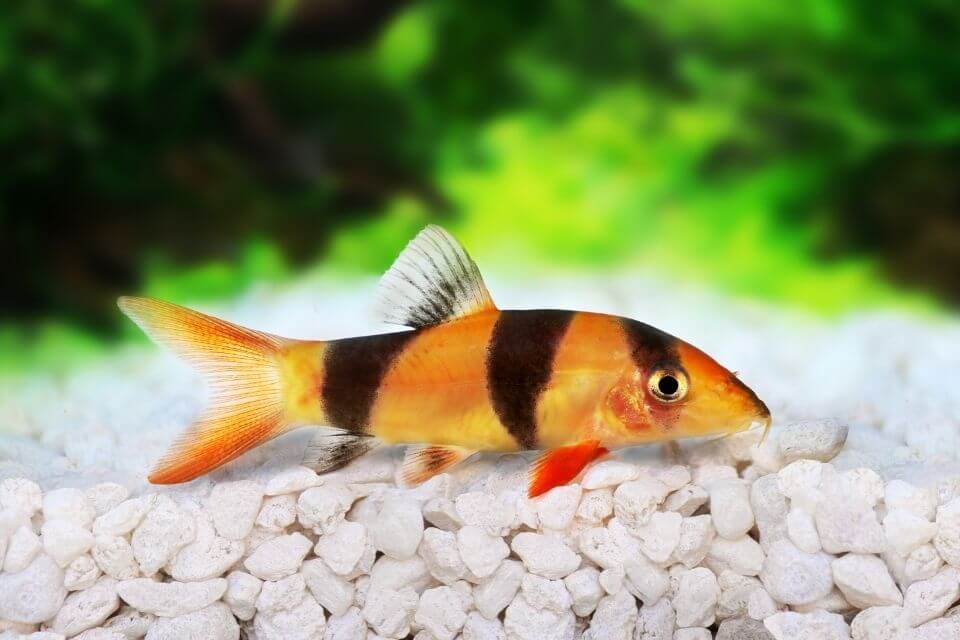
The Clown Loach is native to the rivers and tributaries of Borneo, Malaysia Kalimantan, and Sumatra. However, during spawning, they migrate to the most flooded areas of the rainforest.
These species are very peaceful and can live in a community tank. Their bodies have a deeply forked tail fin to propel them through the water. This species is orange, but with black bars.
The Clown loach can reach a maximum size of 12 inches with a lifespan of over 10 years. Their care level is moderate since they are very susceptible to Ich.
The diet of the Clown loach comprises invertebrates such as crustaceans, worms, and small water-dwelling snails. They can also feed on algae and decaying matter.
14. Rainbow Fish
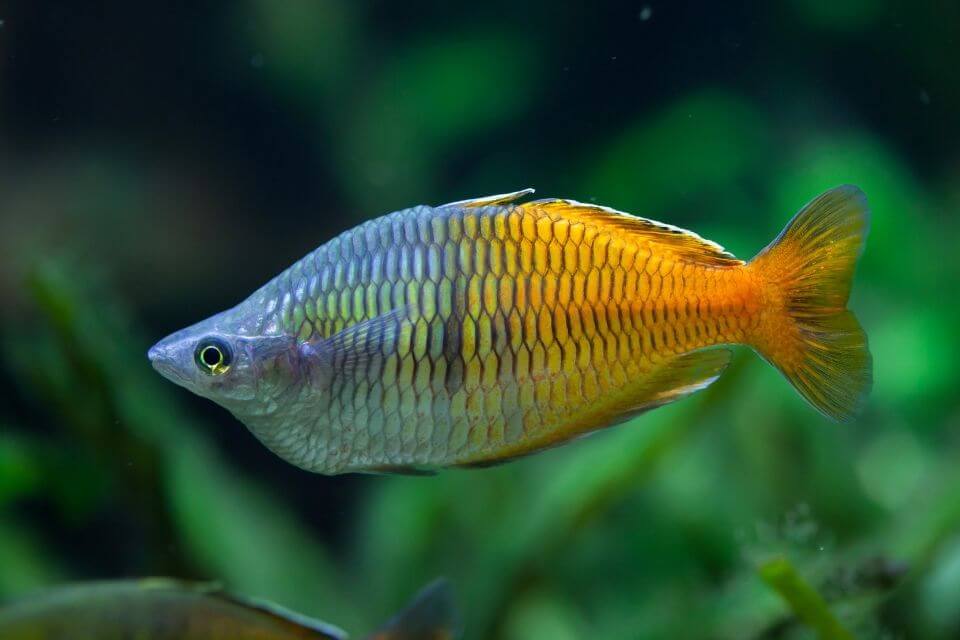
Rainbowfish are colorful freshwater fish and are composed of two main groups. The first group includes; Families Telamatherinidae and Pseudomugilidae. The second group consists of the families Bedotiidae and Melanotaeniidae.
They originate from Madagascar, Australia, and New Guinea. Rainbowfish are the most peaceful species in an aquarium. However, having more than one male in a tank could lead to injuries during the breeding season.
You should limit your tank to one male per tank. Rainbowfish have a wide range of colors and two dorsal fins. The majority of rainbow fish have red-orange fins, pink bellies, and silvery blue-green bodies.
Additionally, the males are more colorful than the females. A majority of Rainbow fish have a size of fewer than 5 inches in length, with some measuring less than 2.3 inches, while others have a length of 7 inches.
Additionally, the average life span of rainbow fish is five years but can live for more years with good care.
Rainbowfish are easy to care for and they are omnivores. Meaning their diet should be based on meat and vegetable foods. These foods include glass worms, betta treat, spirulina flakes, blood worms, and ground vegetables.
15. Zebra Danio
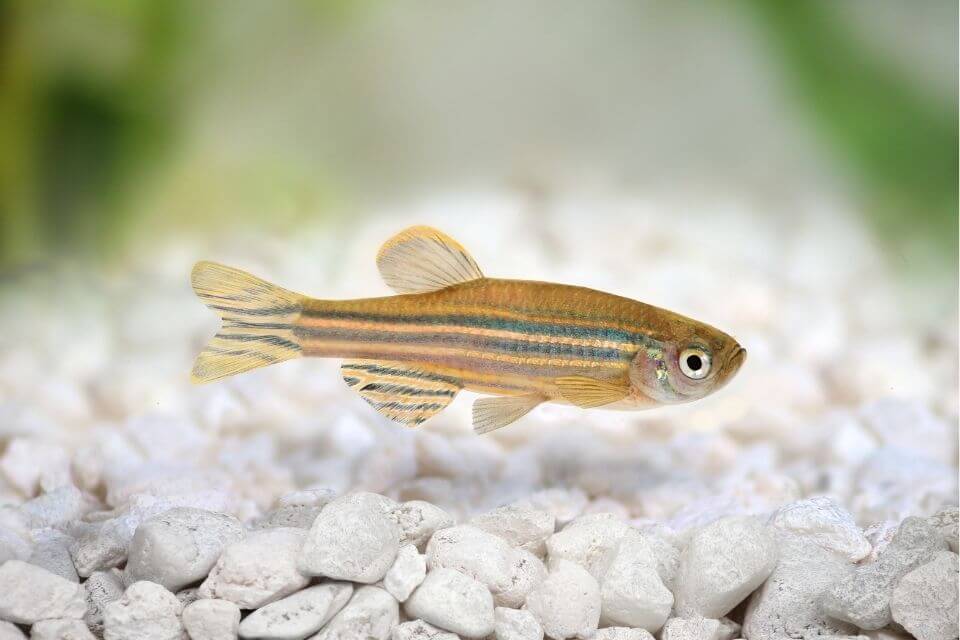
Zebra Danio is also called Zebrafish or Striped Danio. They are freshwater fish and are the most popular fish in an aquarium. Additionally, they originate from Southeast Asia.
Zebra Danios are socially peaceful and exhibit shoaling behavior. However, they are aggressive towards long-finned fish by biting their fins because they move slowly.
The male fish is slimmer than the rounder and fully-bodied females. They have gold/silvery coloration with blue stripes covering the fish from the gill to the tail. The males are more golden than their female counterparts.
The size of a Zebra Danio is an average of 2.5 inches in length. However, when kept in ponds, they can grow larger than this. In addition, the life span of this fish is 3 to 5 years, but with the best care, they could live for more than five years.
Zebra Danio is easy to care for and is an omnivore fish meaning they can eat anything. In the wild, they feed on algae, worms, crustaceans, and mosquito larvae. In an aquarium, they eat a variety of foods such as vegetables, worms, and flakes.
16. Otocinclus Fish
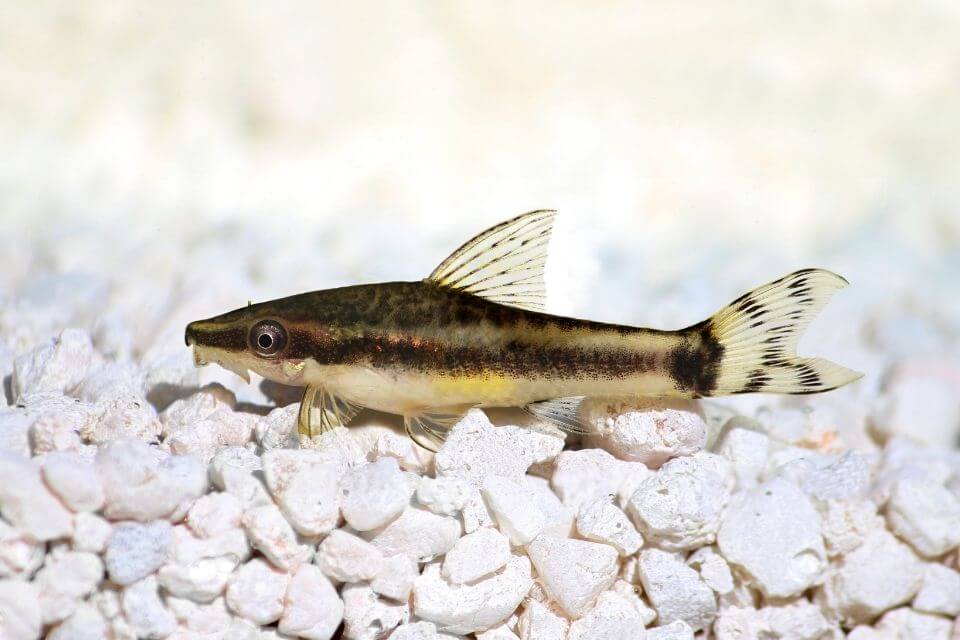
Otocinclus Fish is also called Dwarf Suckers or Otos. Otocinclus belongs to the family Loricariidae and it is a freshwater catfish. It has nineteen species of Otocinclus and originates from South America, mainly Venezuela and North Argentina rivers.
Otocinclus Fish is peaceful and likes staying out of trouble. Otos are skittish by nature since the other larger fish easily eat them in the aquarium. Additionally, they dart across the aquarium tank when they get scared.
Otocinlus has various colors, but most have a brown stripe covering their bodies. Their body has a cylindrical shape that narrows towards the caudal fin and the head. Furthermore, they have rows of plating armor on their bodies.
Octocinclus Fish are very small and grow up to 2 inches in length when mature. Because of their small size, their movement is very quick. In addition, with good care, they live for 3 to 5 years or even more.
Octocinclus Fish are easy to care for since they are undemanding and do not need experience. Additionally, this fish is an herbivore which restricts them to one type of food. The foods they eat include algae, spinach, zucchini, and lettuce.
17. Betta Fish Breeds
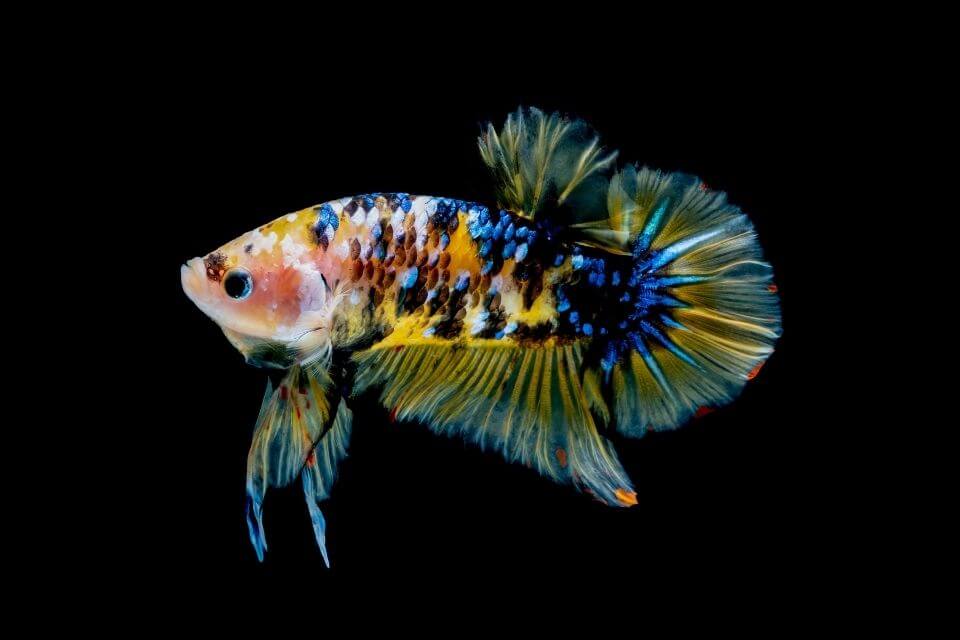
The Betta fish are Siamese Fighting fish because of their territorial nature. Wild bettas live in stagnant water bodies like rice paddies. The betta fish origin is Southeast Asia and is prevalent in Thailand, Vietnam, and Cambodia.
Bettas are aggressive and the males can fight each other to death. Females are more social compared to the males. Additionally, bettas will attack bright-colored fish in an aquarium and get along with the less-colored ones.
Betta fish breeds have many bright, beautiful colors such as red, orange, blue, gold, and white. Additionally, they have long flowing fins, and the tail and fins have a wide range of shapes.
They grow between two to three inches in length. Furthermore, these fish breeds can live between three to five years with proper care and maintenance. Betta fish breeds are easy to care for and require less space than other fish.
Additionally, Betta fish breeds are carnivores; in the wild, they feed on small insects, brine shrimp, and larvae, and in an aquarium, you can feed them worms, fruit flies, and larvae.
18. Galaxy Rasbora
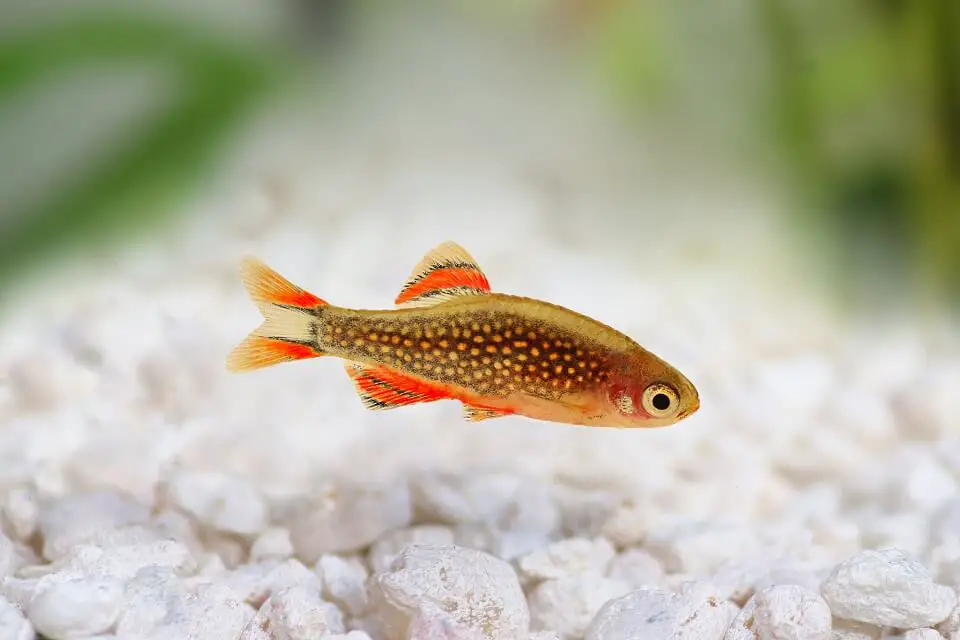
It is also known as Celestial Pearl Danio. Since its discovery in 2006, it has become a favorite for many aquarists. Additionally, they are freshwater fish and originated from east of Lake Inle in Hopong (A village in Myanmar).
Galaxy Rasboras are timid creatures. They do not interact with other fish and are shy. These traits make them peaceful. They live well with other fish in the aquarium tank, though they need many places to hide.
Galaxy Rasbora fins have black lines and parallel lines on the sides with orange and red colors depending on the sex. The males are significantly vibrant in color on the tail and are thin, whereas the females are round and slightly dull.
Galaxy Rasboras are small and grow to 1 inch (2.5 cm) in length from their head to tail. Because of their small size, they are easily preyed on or outcompeted by bigger fish.
Additionally, these fish can live between three to five years in a stable aquarium with good care.
Galaxy Rasboras are more sensitive to infections around them and water conditions. That is why they need a moderate care level. Additionally, they are omnivores and feed on worms, algae, zooplankton, and flakes.
19. Cory Catfish
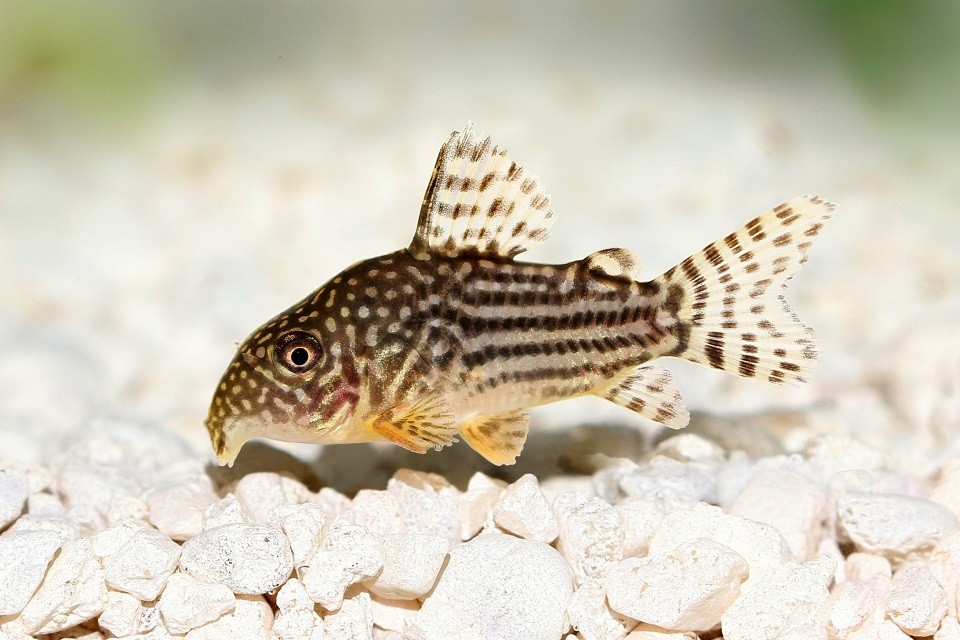
Cory catfish are freshwater fish and have more than 170 species. The common species are cheap, but rare species such as Adolfo or Weitzmani cory catfish are more expensive. In addition, the origin of cory catfish in South America is Argentina.
Cory catfish are peaceful. They do not attack their mates in the tank when threatened. Instead, they hide and such behavior makes it easy for them to live with other fish.
However, some species produce toxins when threatened, killing everything in the aquarium tank. Cory catfish have different colors, including green, albino, black, and bronze.
These fish have a flat underside, a short face, and wide eyes with a ring around them. Additionally, the tail is forked and the dorsal fins are always pointing upwards.
Cory catfish are small and most species are 2.5 inches long. The smallest species are one inch long and the largest species are four inches long. With good care, the cory catfish can live up to five years.
Cory catfish are easy to care for and they are also omnivores that are opportunistic feeders. They feed on daphnia, bloodworms, algae wafers, and shrimp pellets. They also eat the small eggs of the other fish in the aquarium.
20. Freshwater Angelfish
Their beauty has made many aquarists nickname them the “king of aquariums.” The origin of angelfish is the Guana Shield Rivers of South America, the Amazon Basin, and the Orinoco Basin in Columbia.
They are quite aggressive. They form small schools and are not social with the rest of the members of the school. They are also territorial and they would rather fight than cooperate.
Additionally, they do not interact with each other much except during mating. Angelfish have silver, gold, marbled and black colors with four dark bands. Marbled angelfish have jagged irregular bands or black spots.
They also have triangular snouts and arrowheads with large bodies. Angelfish grow up to six inches long and their fins reach a height of eight inches in length.
Furthermore, if kept in good aquariums, these fish have a life span of up to ten years. They mature after ten months of age.
Angelfish are easy to care for and are omnivores. These fish are big feeders per day. They eat at least twice a day, but they eat up to four times during mating. They feed on worms, krill, brine shrimp, and spinach.
21. White Cloud Mountain Minnow
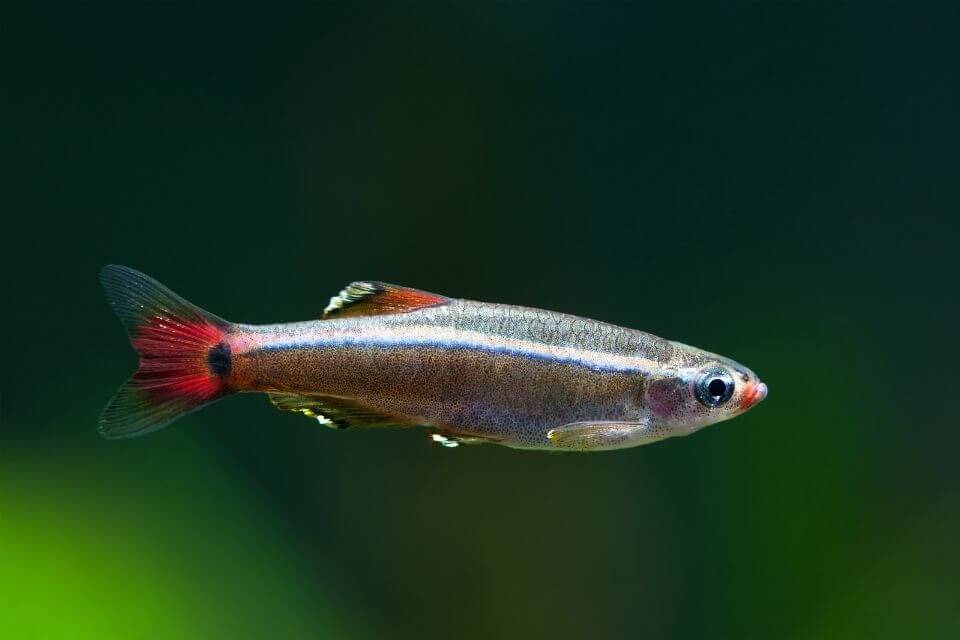
It is also known as Canton Danio or Chinese Danio and belongs to the Cyprinidae family. Sometimes they can be confused with Danios. They are both coldwater and freshwater fish.
White Clouds Mountain Minnows are very peaceful. Although, when looking for mates, the males are aggressive and territorial. These fish are cooperative. They feed and swim in coordinated shoals.
They make good tank mates since they do not compete or harass their mates. These fish have green and silver scales that have black and pink stripes. They have red-tipped caudal fins and snouts and the tail has a black dot.
Additionally, they have pointing snouts, and streamlined bodies, and the ventral and dorsal fins are triangular. White Cloud Mountain Minnows are very small and can grow up to a maximum length of 1.5 inches.
If fed well and taken care of well, they live up to five to seven years. White Cloud Mountain Minnows are easy to care for and are low maintenance.
They are carnivores and you can feed them on foods such as brine shrimp, water fleas, flakes, and alginate tablets. They have big appetites and eat three or two times a day.
22. Harlequin Rasbora
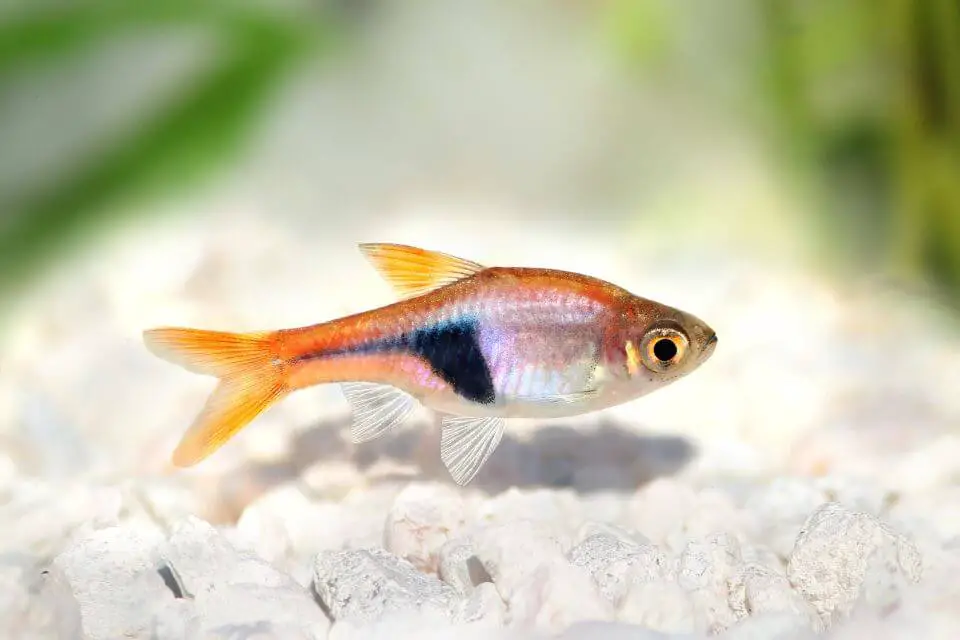
Harlequin Rasboras are also called harlequins and are the most popular rasbora species found in home aquariums. They belong to the Cyprinidae family. The origin of the Harlequin Rasbora is Malaysia, Thailand, and Singapore.
The harlequins are very peaceful and do not harass their tank mates. They spend their time in the middle of the water. Rarely you will see them on the surface of the water.
Additionally, you will see them moving together and displaying impressive performances of swimming patterns.
Harlequins have a silver body with a black patch and forked caudal fin. The fins are dark orange but have different intensities. The males have a more rounded section at the anal-fin point of attachment and large black patches than the females.
The harlequins are small in size and grow up to two inches and they rarely grow more than that. Since they are small many can fit in one tank. If kept healthy, they can live up to 5 to 8 years.
The harlequins have few specific needs and are not demanding, making it easy to care for them. They are also omnivores meaning they eat a variety of foods. You can feed them on foods such as bloodworms, insects, larvae, and daphnia.
23. Serpae Tetra

Serpae Tetra is also known as the Callistus tetra or Jewel tetra and belongs to the Characidae family. It is a species of freshwater. The origin of the Serpae tetra is the Amazon River basin in Peru, Argentina, Brazil, and Paraguay.
These fish are very peaceful and get along with other species in the tank. Serpae tetras are confident in large groups and like exploring their surroundings. They swim in a distinctive pattern and enjoy darting through the water.
Serpae Tetra has a red color with a flat body. All the fins are red except the anal and dorsal fins, which have black and white colors. Additionally, they have a black spot on both sides of the body and a shiny scale that glitters in the light.
The Serpae Tetra grows up to 1.75 inches in size. Though in rare cases, it might reach a length of two inches. Furthermore, they have a life span of five to seven years or more, depending on the care.
The Serpae Tetras are easy to care for since they have fewer needs and are omnivores, meaning they are opportunistic feeders and eat anything. You can feed them foods such as pellets, bloodworms, and high-quality foods flakes.
24. Congo Tetra
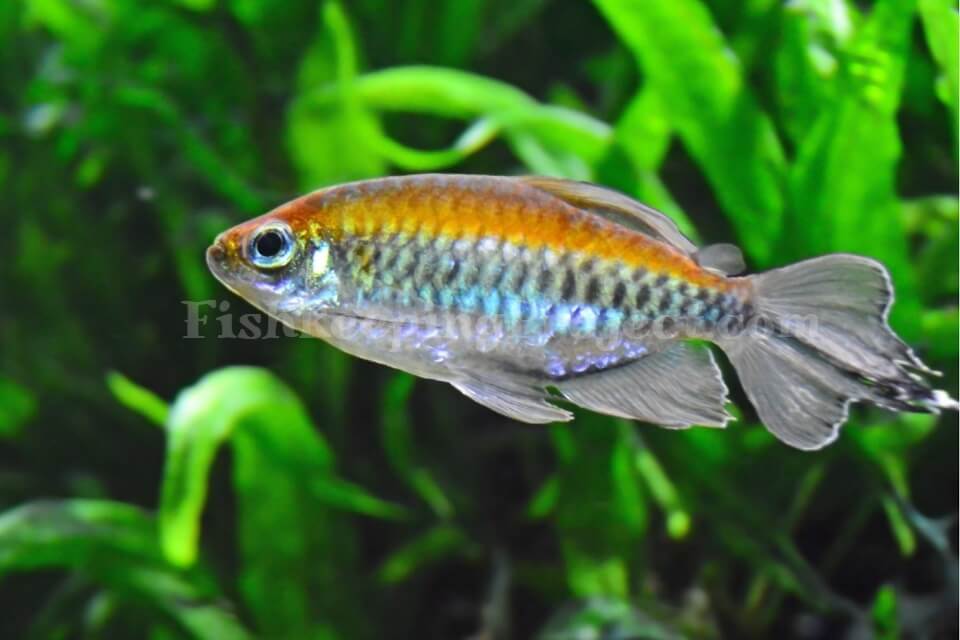
Congo Tetra belongs to the African tetras or Alestidae family. It is a freshwater fish found in marine parks and home aquariums. The origin of the Congo tetra is Central Africa in the river Congo basin.
These fish are very peaceful and enjoy swimming in groups. During the day they are most active, they will swim together and separate to explore independently. They get along with other mates so long as they are not aggressive fighting species.
The congo tetra has tropical colors from blue and purple to orange. It has a stripe that runs across the body and glitters in red and orange colors.
The congo tetra fish has a tetra shape, covered in scales. Additionally, they have gray and violet transparent tails.
The females are smaller than the males and have a size of 2.75 inches and the males have a length of 3.5 inches. The congo tetras are the largest tetra fish. They have a life span of three to five years.
Congo Tetra requires a moderate care level since it has more specific needs. The congo tetras are omnivores, meaning they eat a variety of foods. You can feed them foods like bloodworms, brine shrimp, omnivore pellets, and flakes.
25. Rainbow Shark
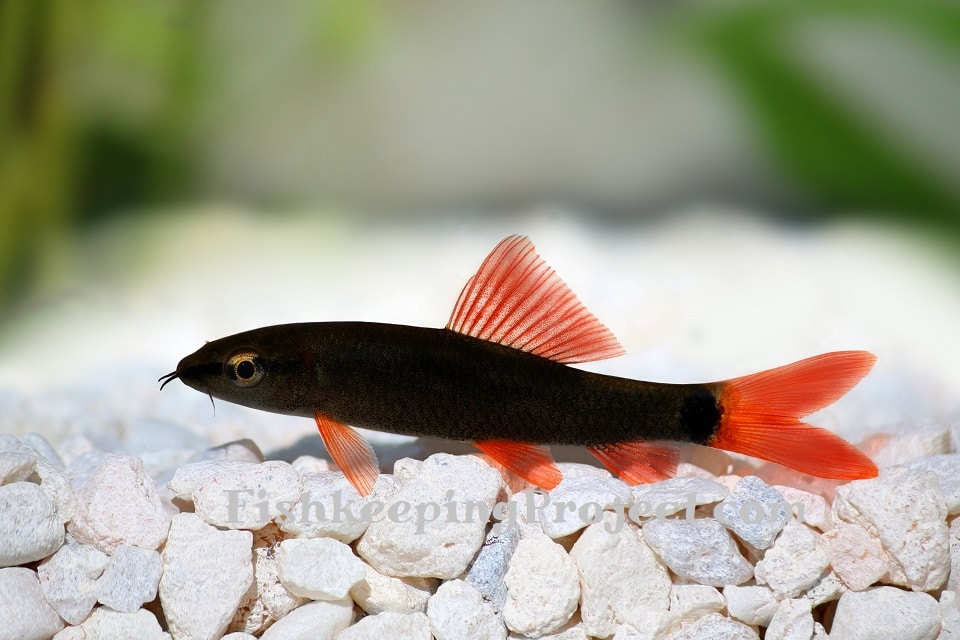
Rainbow Sharks are also called Ruby Sharks, and Red-fin Sharks. They are freshwater fish. Rainbow Sharks belong to a family known as Cyprinidae. The origin of Rainbow Sharks is in Southeast Asia in Thailand.
Rainbow Sharks are aggressive, enjoy exercising dominance and guard their territories. They fight with their kind and bottom-dwelling fish by biting, tail, and head butting and chasing.
Rainbow sharks have orange and red fins. Their bodies are either black or gray and are long and slender. Their dorsal fins have elven-branched rays with forked tails. Additionally, their faces are flat and their eyes are sunken.
The Rainbow Shark grows up to six inches in length. However, some grow up to eight inches in length. The life span of these fish is four to six years, although some may live up to eight years.
Rainbow Sharks are easy to care for and are not demanding so long as you adhere to care guidelines. In addition, they are omnivores and can eat anything. You can feed them foods such as vegetables, flakes, pellets, and insect larvae.
26. Kuhli Loach
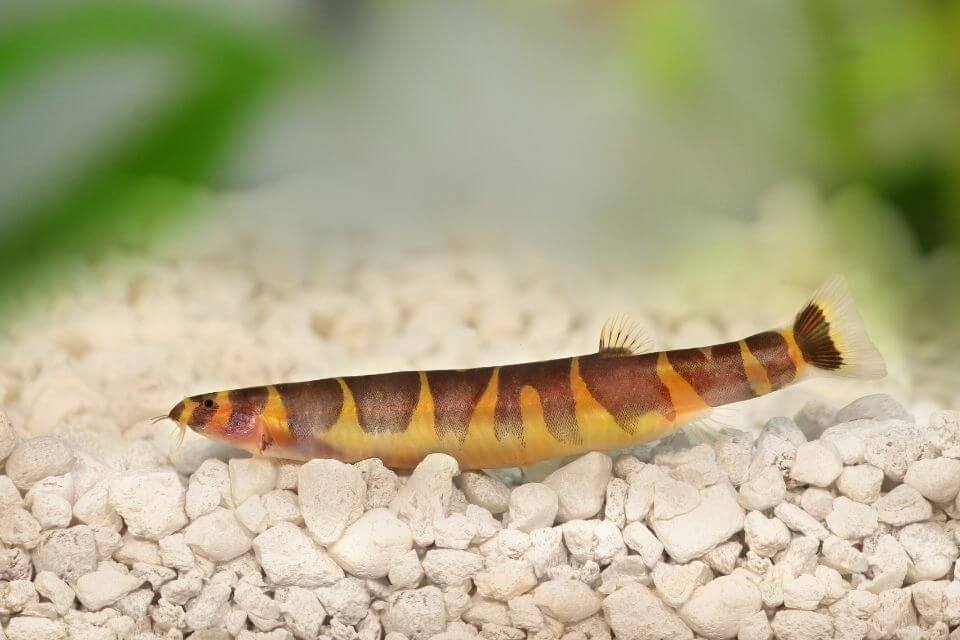
Kuhli Loach is also known as Pangio, Coolie Loach, and belongs to the family Cobitidae. Kuhli Loach is a freshwater species. Additionally, the origin of this fish is Southeast Asia in countries like Borneo, Thailand, and Malaysia.
The Kuhli Loaches are very peaceful and are comfortable with other species in the tank. These fish are very shy and it is difficult to notice them if they are the only fish in the aquarium. They like spending their time below the tank scavenging for food.
The Kuhli Loaches have a wide range of colors. The base side has a yellow-to-pink color. Above the base, they have 10 to 15 dark stripes. Additionally, they have four barbels pairs and eyes covered with transparent skin.
A Kuhli Loaches growing in an aquarium is three to four inches. The wild ones can grow up to five inches. The average life span of Kuhli Loaches is ten years with proper care.
These fish are difficult to care for and require some knowledge and experience because they are susceptible to diseases. Additionally, they are omnivores and you can feed them foods such as daphnia, worms, flakes, and pellets.
27. Convict Cichlid
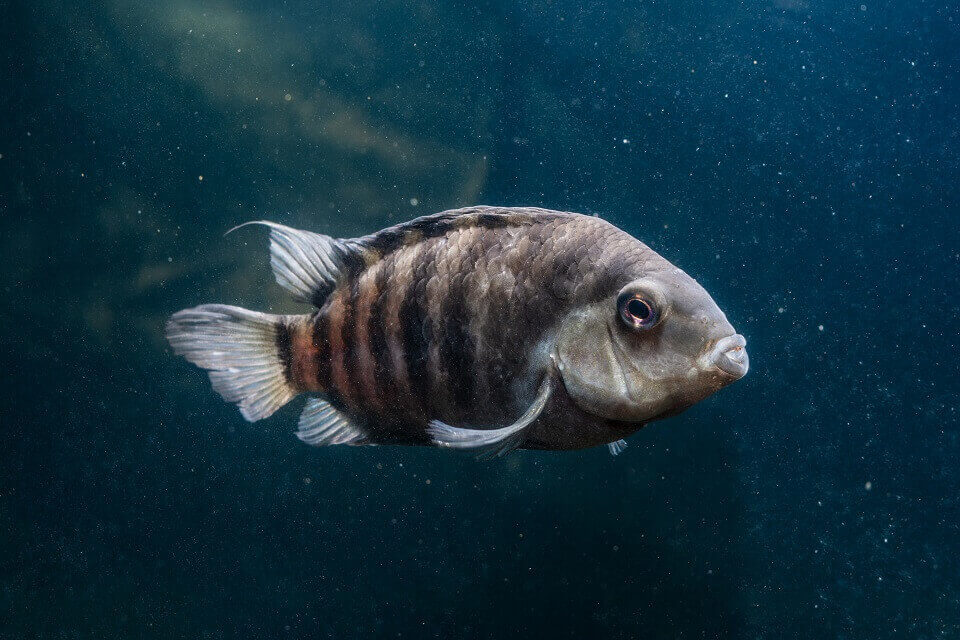
The Convict Cichlid is also sometimes called Zebra Cichlid and it belongs to the family Cichlidae. Convict cichlids are freshwater fish and their origin is Central America in countries such as Honduras, El Salvador, and Guatemala.
The Convict Cichlids are active, very aggressive, and territorial. When a fish trespasses its territory, it defends by harassing and chasing the other fish. They spend their time near their territories and plant matter. The Convict Cichlids have black and white stripes.
They have eight to nine stripes across their grey bodies. Males have a larger dorsal fin and anal while females have smaller. With selective breeding, gold, white and pink varieties exist.
Convict cichlids have an average size of four to six inches when matured fully. The average life span of convict cichlids is eight to ten years. They can live for more than ten years with proper care and feeding.
Convict cichlids need moderate care, where you have to understand their aggressive and territorial tendencies. Additionally, these fish are omnivores and eat any food placed in the tank. You can feed them worms, carrots, brine shrimp, and daphnia.
28. African Cichlid
African Cichlids are freshwater cichlid species and belong to a family called Cichlidae. The Cichlidae family has over 1500 species. Additionally, the origin of African cichlid is Africa from Lake Tanganyika, Lake Malawi, and Lake Victoria.
African Cichlids are aggressive and territorial when mating. They are also good swimmers and will jump out from the aquarium tank if provoked or spooked. Additionally, they may dig up decorations or the substrate in search of food.
The African cichlids have small teeth to catch fish and scrape algae from rocks. They have various colors, including yellow, blue, orange, and gray. The males are more colorful than the females.
African cichlids have an average of three to eight inches in length. Additionally, they have a life span of ten years, but some may live up to fifteen years with proper care.
They require a moderate care level because you need to understand their aggressive behavior. Additionally, African cichlids feed on both meats and plants in the aquarium.
29. Peacock Gudgeon
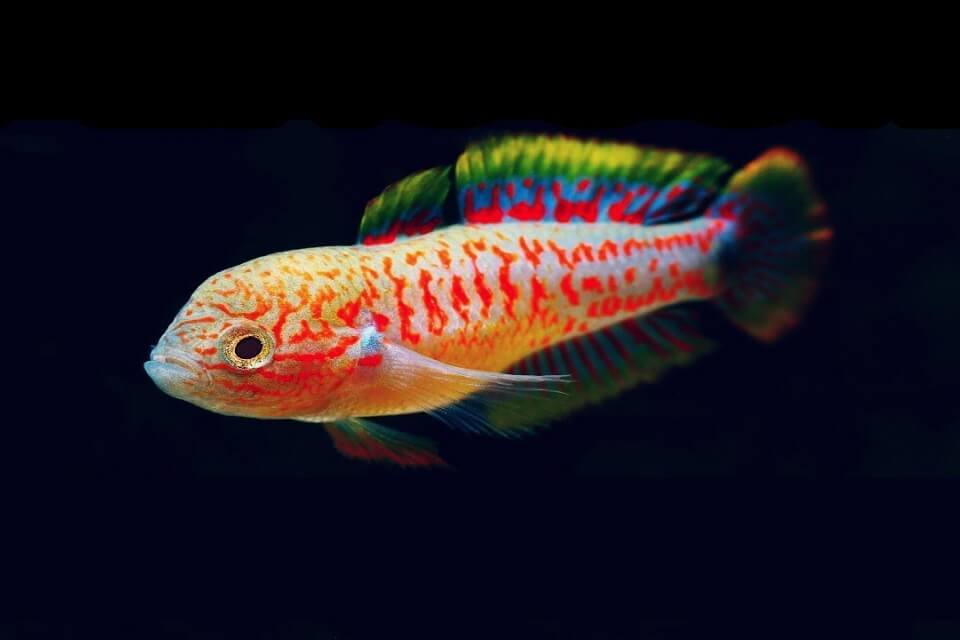
Peacock Gudgeon is a freshwater fish that belong to the Eleotridae family and are a member of the Tateurndina Genus. Though sometimes it is called Peacock Goby, it is not part of the Goby family.
Peacock Gudgeons originate in shallow and still water bodies in the Eastern parts of Papua Guinea. Peacock Gudgeons are peaceful and swim in a group of six to eight.
They like to hide in places when under threat, so make sure the aquarium has many hiding places. You need to ensure the aquarium is fitted with a tight lid since they are gifted jumpers.
Peacock Gudgeons have a silvery-blue body with red dots, their bellies have a yellow hue and the fins are yellow at the edge. The males have a forehead hump and the females have a black strip on their fins.
Additionally, they have slender bodies and rounded heads. Peacock Gudgeons are three inches long, while the female is only 2.5 inches long. In addition, they have a life of four to five years if given proper care.
Peacock Gudgeons are easy to care for. They have fewer needs and are less demanding. They are also omnivores and you feed them high-protein food mixed with worms, daphnia, and brine shrimp.
Final Thoughts
In conclusion, a home aquarium makes a house look beautiful and you may desire to have one. It is important to know which types of fish you can start with as a beginner.
In addition, it is also important to know which type of fish cohabitates well with others. Having this knowledge will help you avoid the loss of fish in your aquarium.
You will also be required to know which type of food to feed them and learn to rotate the menu.
If you feel knowledgeable and confident about the fishkeeping hobby, you can go ahead and try it. Even if you fail for the first time, do not give up. Learn from your mistakes until you become a good aquarist.


